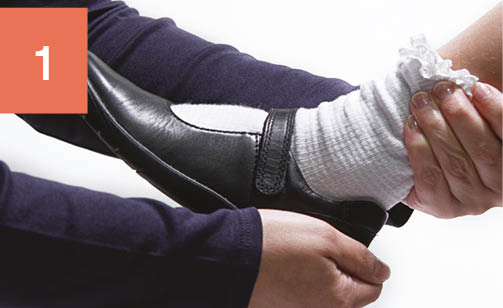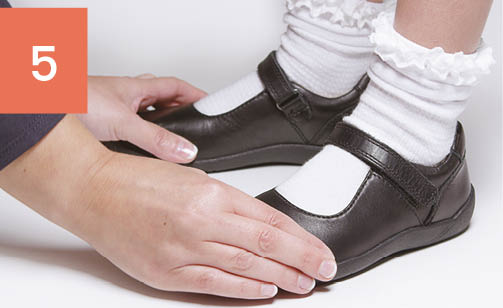It’s important to understand that when it comes to children’s shoes, measuring is only a guide and you must always check the fit on the foot. Two feet that measure a size 2, can look really quite different, so different shoe designs will better fit different foot shapes. In addition to this, different manufacturers will use different materials and methods and this can also effect how styles fit. Here is our guide to check if your chosen style properly fits your child’s foot.
As with your own shoes, you do not want the shoe to be too tight and rubbing at any point of the foot, equally if a shoe is too big and loose, toes will need to scrunch to keep the shoe in place and the way the foot behaves, informs the development of the body above it.
It's important that the shoe grips the heel well so that it doesn’t slip while the child is walking. With Start-Rite shoes, when the heel is gripped efficiently, it allows for the extra growing room at the front of the shoe.
Measuring is only a guide and it is therefore important that once your child’s shoes have arrived you check they fit correctly. This is because not all feet are the same shape – neither are shoes. Depending on how they’re made, different styles can fit slightly differently.
By following our step by step guide, or by watching our 'check the fit' video below, you’ll confidently and quickly be able to tell if your children’s shoes fit their feet.
Don’t worry if they don’t fit – we have free returns on all UK orders so you can pop them back to us free of charge for a full refund. Check out our returns policy for full details.

Heel Grip – Whilst your child is sitting, lift one foot up and hold the ankle with one hand and grip the heel of the shoe with your other hand. Pull down gently a few times to check the shoe is gripping the heel well. Now repeat on the other foot.

Top of the Shoe – Ask your child to stand up. Use your fingers to feel around the top of the shoe and check there are no gaps, particularly between the shoe and the heel.

Ankle – Feel around the ankle bone to check the shoe does not touch the ankle bone, as it could rub. If the shoe has a padded collar it is designed to support the ankle and will touch the ankle bone. It will feel soft and padded.

Length – Feel the top of each shoe for the end of your child's longest toe. Apply gentle pressure to check the toe is not pressing against the end of the shoe. All our shoes have growing room built in; you should be able to feel the growing room with your thumb.

Width – Feel along each side of the shoe with your hand, you shouldn't feel any pressure or bulging at the sides, and the widest part of the foot should be in the widest part of the shoe.

Depth – Rub your thumb across the top of the shoe, you should feel the leather move with a shallow ripple effect. If there is no movement at all the shoe is too narrow, if you can push the leather into a ridge the shoe is too wide.

Depth – With a low cut shoe, run a finger under the top part. Make sure it’s not so tight that the foot bulges out of it, and not so loose that there’s a big gap underneath.

Walking – Ask your child to walk in the shoes. They should be able to walk easily and naturally. The shoes should not slip off the heel, and there should not be excessive gaping at the sides.
Watch our video below to make sure your children’s shoes fit correctly. It will guide you through each of the steps above.
Your fingers are the key to checking if your child’s shoes are too big.
The age old rule to check if a shoe is too big is to push down at the front of the shoe, to check where the big toe is. For comfort, there should be roughly a finger’s width of space between the toe and the end of the shoe. Check the top and heel of the shoe by running your finger around. If it’s easy to place your finger between your child’s foot and the leather, then the shoe is too big.
Run the finger check as above and if you can feel the big toe is close to the end of the shoe, it is too small. Similarly, if you struggle to squeeze your finger between your child’s heel and the back of the shoe, or up and under the top of the shoe then they are too small for the child and will soon rub the skin and can cause blisters.
It's also a good idea to ask your child to walk around in the shoes and ask if the shoes feel comfortable from underneath. The ball of the foot should fit comfortably as this is the widest part of the shoe. Watch your child and ensure that they are walking in their usual way. If the shoes look a little too tight, try going up half a size, or try a wider width size. Different styles fit different shapes and a larger width will also impact the length and can make all the difference in the comfortable fit of a shoe style.
If you want to check the fit at home, use our Children's Shoe Size Calculator for added peace of mind.
It’s important that children’s shoes fit and a child does not where the wrong size shoes. Just with clothes shops there is no standard sizing. For example, did you know that Start-Rite shoes measure a half size different to Clarks? Our shoes tend to come up half a size larger, so if you use a Clarks measure but want to buy Start-Rite, you should try shoes half a size smaller than your measurement at Clarks.
If, for example a child’s toes are scrunching to keep a pair of shoes that are too big, on their foot, not only can this put pressure on your child’s leg muscles, this behaviour can send all the wrong messages to the brain which can interpret it as a physical issue and the brain might take measures to compensate for the changed walking pattern.
Children must feel supported by their footwear and particularly when it comes to sports. The general rule for sports shoes is that the heel should be supported and the base of the trainer must add cushion and support for the heavier tread, while toes should feel free at the top of the shoe. If trainers are on the tight side, they will also become uncomfortable as the foot swells with the heat and increased activity, so use your fingers as described above to ensure plenty of wiggle room in trainers. Check out our range of girls school trainers here.
Size is still important in wellies, even if they look much bigger and your child will be wearing thick socks inside their wellies, you must not go up a size to compensate for this. Children spend a lot of time in wellies, physically active exploring the world outside and just with a pair of shoes, you should make sure that they are getting the right support for their feet. See our super range of colourful wellies here.